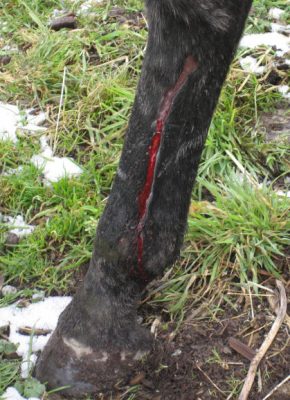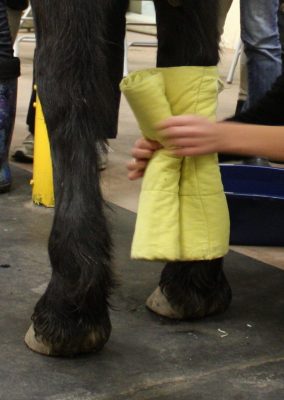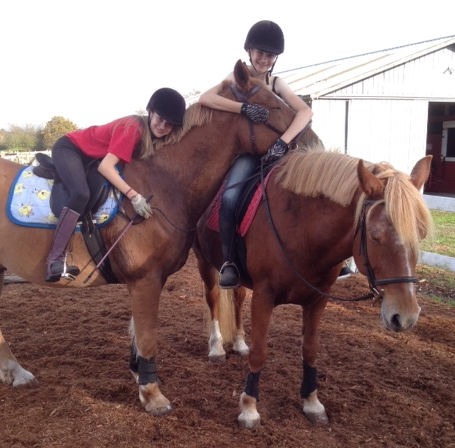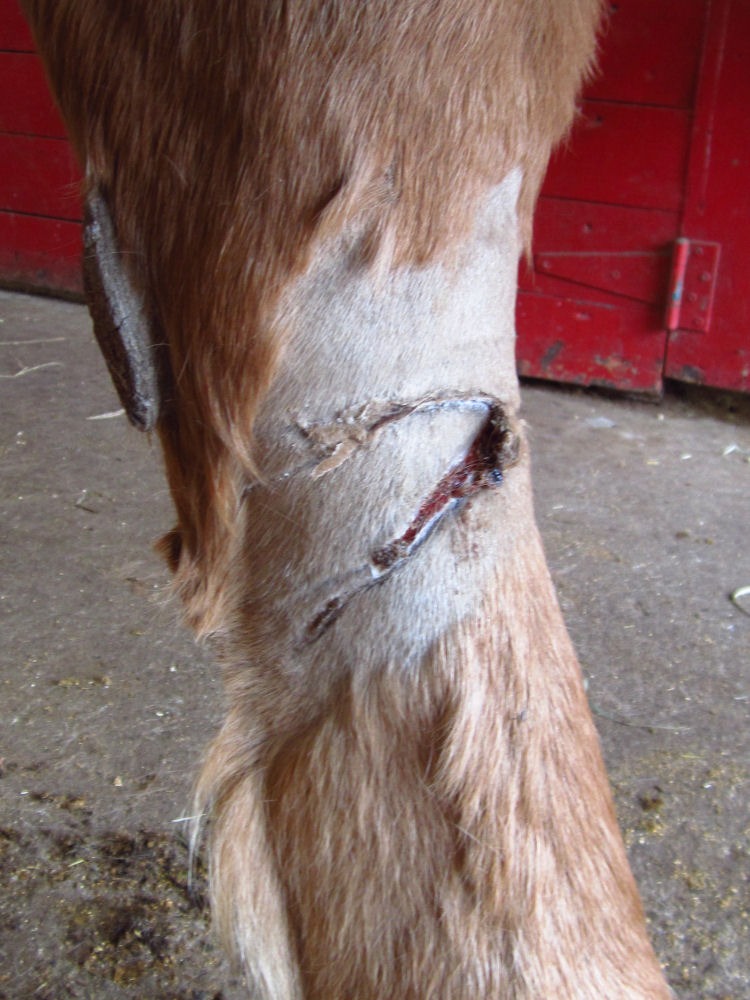Horsemanship Level 3: Wound Treatment
Last week we looked at when to call the vet and what to do until she arrives. In the case of wounds, some warrant a vet call and some don't; some need treatment and others don't. How do you tell, and how do you treat the wound before and after the veterinary visit?
Size doesn't matter
Or rather, the size of a wound doesn't indicate the severity. A large scrape that is quite ugly to look at may require no treatment, while a small, almost unnoticeable puncture or tendon sheath injury could be career-ending or even deadly. It is important to recognize the types of wound:
- Puncture. Often small and easily missed, punctures are among the most dangerous types of wound, and are usually caused by a long object such as a nail or stick that penetrates the hoof or body. Punctures can drive bacteria into the tissues, which can cause lameness or life-threatening infection.
- Clean cut (incision). This is a cut with straight edges, usually caused by a single sharp object. A clean cut over muscle mass will almost always require stitches to assist healing and prevent scarring. An arterial wound (one in which blood spurts) needs immediate pressure to stop the bleeding followed by stitches and/or bandaging. If the cut is over a joint or is leaking clear or yellow fluid, veterinary attention is needed. A tendon or joint injury can cause permanent lameness if not treated.
- Tear (laceration). This is a wound with ragged edges, often larger and messier looking than an incision. Lacerations are often, but not always, shallower and less dangerous than incisions, although they are harder to stitch because of the ragged edges. In some cases the vet may simply cut away torn skin; in others she may stitch the wound. This depends on the size and location: some areas of the body heal quickly and others are more delicate. Always ask your vet, and never try to determine on your own whether a large laceration needs stitching.
-

Scrapes can look dramatic but usually heal well if left alone Scrape (abrasion). This is a superficial wound that removes hair and the top layers of skin. Most scrapes are treated by removing any debris and otherwise leaving alone.
- Bruise (contusion). Bruises are hard to spot on horses, but are often characterized by a raised, warm, or sensitive area on the body. Stone bruises can be seen on the soles of light-hooved horses, but can only be detected by symptoms (lameness, sensitivity) on dark-hooved animals.
General Wound Treatment
When treating a wound the number one rule is stay calm. You need a clear head to prevent further injury and you can only calm a frightened and hurt animal if you are calm yourself.
There are four basic steps in treating a wound, some of which do not apply to all wounds. However, it's good to have this checklist in the back of your head to make sure you don't miss anything.
- Stop the bleeding. This only applies to arterial wounds, in which the blood is bright red and spurting. All other wounds, with darker blood or synovial (clear or yellow) fluid, will benefit from being allowed to bleed lightly to flush out foreign matter.
- Clean the wound. Gently remove any obvious debris, and if the wound is very dirty wash with clean water from a bucket, using an antiseptic solution if possible. Do not use a hose, as this can force dirt back into the wound. In general, leaving a non-arterial wound to bleed until the vet arrives or the wound begins to scab is the best way to keep it clean. You can carefully clip the hair around the wound to make it easier to treat, but be careful not to contaminate the wound with hair and more dirt.
- Cover the wound. This is to keep the wound moist to speed healing, and to prevent dirt from getting in the wound. Antibiotic ointment on a piece of gauze can can be kept in place with bandages, but sometimes bandaging is difficult or impossible. In these cases leave the wound bare, and avoid using ointments or powders as these will attract dirt.
-

Applying a pillow quilt Bandage. If using gauze, a bandage can be applied to hold it in place. Wounds on the body can be covered by gamgee (cotton wool) and duct tape. Duct tape over paper towel makes a good poultice and covering for an abscessed or punctured hoof. A standing bandage on the leg consists of a pillow quilt held in place by a long bandage. This combination distributes pressure evenly on the leg and keeps dressings in place. This helps to prevent stocking up (swelling in the leg). It's often beneficial to wrap both front or hind legs, even if only one has an injury, to give the non-injured leg support. Bandages should be tight enough to stay up, but not so tight as to impede circulation, and should be evenly applied. A poorly applied bandage can do more harm than good. Have someone teach you how to bandage properly and practice on a healthy horse so you're an expert by the time you need to deal with an injured one. Bandaging is an entire topic that is covered more completely in Horsemanship Levels 4 and up.
Once treated, wounds should be inspected and dressings changed twice a day to ensure they have not become dirty, that bandages are not impeding circulation or putting pressure on tendons, and that dressings haven't slipped. The exception is hoof poultices, which can be left on for a day or longer if they don't wear through.
If possible keep your horse in a stable. The less he moves about, the faster the wound will heal, and the less likelihood there is of him getting the wound dirty or removing or tangling his bandages. Horses that get their bandages caught in fences are likely to panic and cause themselves more injury.
Puncture Wounds
If the object is still in the wound, leave it there and put a donut bandage (a ring of twisted cloth) around it, then bandage to secure the donut in place until the vet arrives. DO NOT remove it yourself unless you have to. Removing the foreign object can cause severe bleeding if an artery was damaged, or can cause the wound to start to close up before it can be cleaned. If the object is in the foot and you need to remove it, circle the wound with a marker so you can find it again when the vet arrives.
If you are not sure of the date of your your horse's last tetanus shot, your vet should give him a booster. Tubbing (soaking the hoof in epsom salts) and poulticing can help draw foreign matter, pus, and bacteria out of the wound.
Cold Treatments
Bruises and inflammation can be eased by icing and cold poulticing in the first 24 hours after the injury. After that period, exercise is usually the best way to decrease swelling unless the wound has been sutured (in which case movement can tear the stitches or reopen the incision). The common practice of cold-hosing, or running cold water on legs, should be avoided on any areas with still-healing wounds. As mentioned above, hosing can force dirt into a wound, and the excessive moisture may cause a healing wound to grow proud flesh, (granular tissue that grows past the skin boundary).
Keep a Watchful Eye
If at any time during the healing process your horse develops a fever, goes off his feed, or becomes listless or more uncomfortable, call the vet again. Infection may have set in, and if antibiotics were not at first prescribed, they may be necessary now.
Also watch for proud flesh on the healing wound. Bubbly looking flesh that looks a bit like salmon roe and protrudes past the edge of the skin can be scraped off with a thumbnail. It will bleed a lot, but has no nerves and must be removed for the wound to heal smoothly.
Next week: foot and shoeing
Last Cavaliere Class for 2014
Our last class for 2014 is this Sunday, December 14th. We will be doing riding and horsemanship assessments (let me know ahead of time if you want to assess) and replacing regular sword drills with some fun on horseback. I'm not saying what exactly -- you'll have to turn up to find out! Also, rumours have it that holiday treats may be on hand ....
Sunday 14 December, 1:00 - 4:30pm
Cost: $60 or one flex pack credit
Regular Cavaliere Classes and Mounted Combat workshops will resume in February.
Lease Special
 Need more practice time in the saddle? We have a winter special for Academie Duello students only during the months of November, December and January. Lease one of our school horses for one day per week for a cost of only $115 per month (saving $20 per month over regular rates), or $300 for the whole three month period — a savings of $105!
Need more practice time in the saddle? We have a winter special for Academie Duello students only during the months of November, December and January. Lease one of our school horses for one day per week for a cost of only $115 per month (saving $20 per month over regular rates), or $300 for the whole three month period — a savings of $105!
Leases include one free lesson per month, and additional lessons can be booked for $35 each. You must have Riding and Horsemanship level 1 or the equivalent to qualify for a lease. Flex-pack credits may be applied to the lease. Contact Jen at jennifer(at)academieduello.com for more information.
